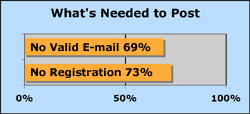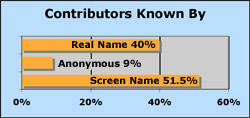The forms that citizen contributions take are easier to imagine if you strip away the term “journalism.” People who are interested enough in local affairs to hang out at a community web site, but who are not professional journalists, rarely appoint themselves to go out and collect research, conduct interviews and file fully reported pieces.
The forms that citizen contributions take are easier to imagine if you strip away the term “journalism.”
More commonly, citizens contribute pieces of information to narratives that take form over a series of posts, or in tandem with other posters. Or they post raw audio or video feeds from public hearings, or original filings or documents that illuminate events. Citizens who are passionately interested in particular issues – development, green spaces, schools, crime, transportation – use sites to draw attention to actions by businesses or developers, or to legislative proposals or neighborhood issues that the posters consider to be under-covered in local media.
Typical is a post to Philly Future from August 2006. It wasn’t journalism but an appeal for engagement. “Last week, a 19-year-old kid was shot and killed a few blocks from my house right by Louis Kahn Memorial Park on 11th and Pine Sts. The photo above is a makeshift memorial of candles, scrawlings and stuffed animals for the deceased Jamil Burton,” the poster wrote. “The neighborhood I live in is having a community meeting tonight at 7p in Louis Kahn Memorial Park to discuss what happened last week in our neighborhood and what continues to happen all over Philadelphia…I don’t have any earth-shattering answers, but maybe as we come out of our shells in our community, we can start to carve something out.”
These may not meet the definition of “news,” but like the best forms of journalism, they shine light in dark places.
Such as the day last winter when Bakersfield, California, radio host Rachel Legan posted a masterfully written and poignant column on Northwest Voice. She disclosed that on her 21st birthday, her then-husband was convicted of raping a real estate agent. In the column she discussed how she had blinded herself to behavior she didn’t want to see. Legan—who more typically muses on light subjects, such as who gets the friends in a divorce—wrote in that post, “I feel like I’m publishing my gut right now, but it’s a story I have wanted to tell for a long time.” The discussion migrated from the site to her radio show and prompted the launch of a program to help young women in abusive relationships.
A fundamental fact of citizen media is that what citizens choose to publish is unpredictable.
In June 2006, Clyde Bentley published on the “Voices” page of MyMissourian.com what he called a stunningly well-written essay that came in unsolicited from an administrator in a CPA firm. The writer gave a detailed account of attending the funeral of a distant acquaintance, a local 19-year-old Marine killed in Iraq. She went on to ponder what was “enough” of a response, suggesting in the end that readers “fight past shyness” and say a “thank you” to anyone they saw in uniform.
“Those pieces were always out there,” Bentley said, “and we somehow missed them.”
A fundamental fact of citizen media is that what citizens choose to publish is unpredictable. Even on sites where the front page is dominated by staff-reported pieces, surprises arrive via forums, comments and other original posts. For example a citizen sends a poem or a short story, which causes the site runner to decide – do we publish creative writing? At many sites the answer is yes (site operators note that newspapers once regularly published poetry and serialized novels). Indeed, 29% of the respondents in our survey said their sites posted creative writing.
Site owners or volunteer caretakers nonetheless exert great influence over content. They do this through their choices of platform and design standards (bright graphics induce light-hearted posts, posts with pictures get more hits). They do it through the mission statements they craft, through the terms of service they enact, through the nature of the posts they showcase and through the editorial controls they impose. These include whether to screen posts and comments; whether and when to edit; how to define “local” content and whether to let every new post automatically go to the top, or to let an invisible hand decide story “play” or placement.
Survey Highlights
While citizen journalists don’t particularly aspire to be called “journalists,” 104 of 131 survey respondents (79%) said they considered the content on their site to be “journalism.” In describing it, 46% said it was mainly news and information; 31% said it was mainly opinion and commentary and 23% said content consisted of “other” things.
 |
 |
Stories (67%), comments (65%), photos (64%) and calendar listings (55%) were the most frequently cited types of content appearing on respondents’ sites. Other types included columns (41%), press releases, (37%) and videos (30%).
Overall there was little accountability built in for content contributors: 73% of all respondents said their sites didn’t require users to register; 69% said a valid e-mail was not even required before posting. Only 40% of 141 respondents said their sites required contributors to use their real names; 60% said their sites allowed either anonymous posts or the use of “screen” names.
